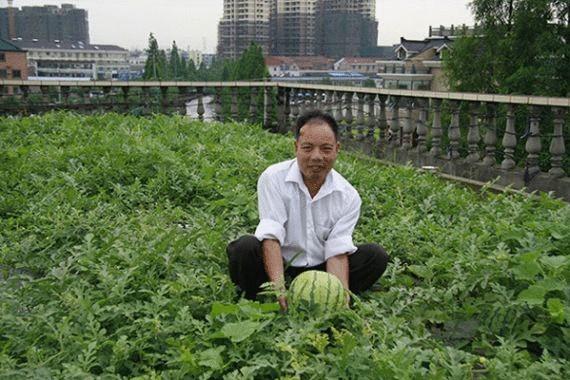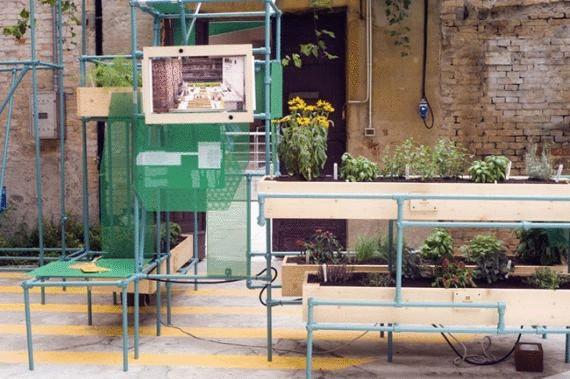Green roofs China
 Bashny.Net
Bashny.Net
Chinese megacities, literally, bursting at the seams. Now the country is experiencing the fastest-growing urbanization in human history. Every year more than 15 million people move from rural areas to cities.
It is expected that by 2025, Chinese cities will live on 400 million more in total, amounting to nearly 900, million people population. Currently, the number of people has reached 1370 million. In response to growing urbanization and the problems of air pollution in the country, Chinese people invented the concept of "garden city". The model of "garden city" can serve not only as a source of food and fresh agricultural products, but also provide more jobs for farmers. As a bonus, urban agricultural land can also benefit in the form of rural tourism or a special course for education.


At the most basic level, in the simple homes of ordinary citizens the concept has already been implemented in practice. Zhang Haichun (Zhang Guichun) 57 year old farmer of his organic "hanging garden" on the roof of a traditional Riad house in the southern part of Beijing. "Even if we do not have enough land in the city, agriculture may just go up on the roof and balconies," says Zhang.
Zhang, who practices traditional Chinese medicine, began to grow his garden five years ago and now his site is growing about 30 varieties of vegetables and fruits, including tomatoes, cucumbers, sweet pepper and melon. This is enough to feed the whole family.
In addition to providing families safe and nutritious food, Zhang for example vertical farming offers many other tangible benefits. The rooftop garden helps to keep home cool in summer, helps to reduce the number of mosquitoes, as tomatoes are natural repellents of insects. "And one very important point — the garden helps to make friends with the neighbors," laughs Zhang Haichun. "The neighbors like to come here to chat in a relaxed atmosphere or just to relax among the plants."

But people like Zhang are still rare. For green roofs the necessary energy, skills and practical experience. "But with a positive advertising campaign and advanced technologies, I think my experiment has the prospect of becoming standard practice in the future. And by that time our cities will not look gray spots with satellites". Such projects help to solve social problems: due to the loss of its arable lands to farmers and the rural work difficult to adapt to city life.
"I lost my land and became rich overnight," says Li Zhi (Li Zhi), a farmer from the village of Chang-Ying (Chang ying) to Chaoyang district (Chaoyang). His village was destroyed, along with 154 other villages. More than 6000 rural residents had to obtain new housing and compensation. Relatives I lost the entire amount of compensation to 200,000 yuan ($ 31600) on the stock market. Now the former farmer is selling fruit on the street. Illegally, without a license. Lee says that though the state and offers courses to alleviate their mental condition, present the desire of the farmer to feel economically demanded. "It's a way of life. And it's hard to get used to something different."

However, Zhang Haichun was right, the concept of "farming on the roof" is supported by more people. Over the last couple years inspired by the idea of a people United in the company turned out to HK Farm, City Farm and Eco-Mama. And just become urban farmers who have been able to do his favorite thing on the roof. Together, they planted tens of square kilometers in the vicinity of Hong Kong.
His work people show in practice how a city can feed its inhabitants and provide much-needed access to green areas. In the end, while there are certain logistical and horticultural problems for gardening on rooftops, the basic principle always remains the same: to find out what plant can grow, and then do what is necessary to help him grow.

Source: /users/104
It is expected that by 2025, Chinese cities will live on 400 million more in total, amounting to nearly 900, million people population. Currently, the number of people has reached 1370 million. In response to growing urbanization and the problems of air pollution in the country, Chinese people invented the concept of "garden city". The model of "garden city" can serve not only as a source of food and fresh agricultural products, but also provide more jobs for farmers. As a bonus, urban agricultural land can also benefit in the form of rural tourism or a special course for education.


At the most basic level, in the simple homes of ordinary citizens the concept has already been implemented in practice. Zhang Haichun (Zhang Guichun) 57 year old farmer of his organic "hanging garden" on the roof of a traditional Riad house in the southern part of Beijing. "Even if we do not have enough land in the city, agriculture may just go up on the roof and balconies," says Zhang.
Zhang, who practices traditional Chinese medicine, began to grow his garden five years ago and now his site is growing about 30 varieties of vegetables and fruits, including tomatoes, cucumbers, sweet pepper and melon. This is enough to feed the whole family.
In addition to providing families safe and nutritious food, Zhang for example vertical farming offers many other tangible benefits. The rooftop garden helps to keep home cool in summer, helps to reduce the number of mosquitoes, as tomatoes are natural repellents of insects. "And one very important point — the garden helps to make friends with the neighbors," laughs Zhang Haichun. "The neighbors like to come here to chat in a relaxed atmosphere or just to relax among the plants."

But people like Zhang are still rare. For green roofs the necessary energy, skills and practical experience. "But with a positive advertising campaign and advanced technologies, I think my experiment has the prospect of becoming standard practice in the future. And by that time our cities will not look gray spots with satellites". Such projects help to solve social problems: due to the loss of its arable lands to farmers and the rural work difficult to adapt to city life.
"I lost my land and became rich overnight," says Li Zhi (Li Zhi), a farmer from the village of Chang-Ying (Chang ying) to Chaoyang district (Chaoyang). His village was destroyed, along with 154 other villages. More than 6000 rural residents had to obtain new housing and compensation. Relatives I lost the entire amount of compensation to 200,000 yuan ($ 31600) on the stock market. Now the former farmer is selling fruit on the street. Illegally, without a license. Lee says that though the state and offers courses to alleviate their mental condition, present the desire of the farmer to feel economically demanded. "It's a way of life. And it's hard to get used to something different."

However, Zhang Haichun was right, the concept of "farming on the roof" is supported by more people. Over the last couple years inspired by the idea of a people United in the company turned out to HK Farm, City Farm and Eco-Mama. And just become urban farmers who have been able to do his favorite thing on the roof. Together, they planted tens of square kilometers in the vicinity of Hong Kong.
His work people show in practice how a city can feed its inhabitants and provide much-needed access to green areas. In the end, while there are certain logistical and horticultural problems for gardening on rooftops, the basic principle always remains the same: to find out what plant can grow, and then do what is necessary to help him grow.

Source: /users/104
Tags
See also
In China, exploded watermelons
SALT: smart radio beacon protects wallet and phone
Build up a Bank of organic seeds or boycott GMO seeds
8 trends of alternative farming
Banana plantations in the community of Paris
The philosophy of permaculture
On the eco farm in Romania foreigners are taught to cook rose jam

















